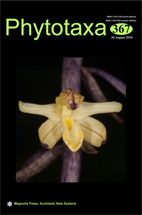Abstract
Hedyotis taishanensis is described as a new species from China. It is similar to H. acutangula, but obviously differs in unbranched herbal stems with slightly winged ridges, petiolated leaves, abaxially pubescent stipules, terminal pleiochasium inflorescence. The phylogenetic analysis from nuclear ITS and plastid petD sequences of 27 taxa revealed that H. taishanensis was an independent lineage but closely related to the clade including the sympatric species endemic to the Pearl River Delta, Guangdong, China. It was evaluated as Least Concern according to the IUCN Red List Categories and Criteria.
References
<p class="Reference">Bentham, G. (1852) Florula Hongkongensis: an enumeration of the plants collected in the island of Hong-Kong. <em>Hooker’s Journal of Botany and Kew Garden Miscellany</em> 4: 164–172.</p><p class="Reference">Chen, T. (2007) A new species in the Genus <em>Hedyotis </em>(Rubiaceae) from South China. <em>Edinburgh Journal of Botany</em> 64 (3): 331–334.</p><p class="Reference"> https://doi.org/10.1017/S0960428607004805</p><p class="Reference">Chen, T. (2008) Notes on the identity of <em>Hedyotis yangchunensis</em> (Rubiaceae) in Hong Kong. <em>Harvard Papers in Botany</em> 13 (2): 283–288.</p><p class="Reference"> https://doi.org/10.3100/1043-4534-13.2.283</p><p class="Reference">Dutta, R. & Deb, D.B. (2004) <em>Taxonomic revision of Hedyotis L. (Rubiaceae) in Indian sub-continent</em>. Botanical Survey of India, Kolkata, 211 pp.</p><p class="Reference">Deng, S.J. & Wang, R.J. (2012) <em>Hedyotis nankunshanensis</em> <em>sp. nov.</em> (Rubiaceae) from Guangdong, China. <em>Nordic Journal of Botany</em> 30 (3): 302–307.</p><p class="Reference"> https://doi.org/10.1111/j.1756-1051.2012.01509.x</p><p class="Reference">Guo, X., Simmons, M.P., But, P.P.H., Shaw, P.C. & Wang, R.J. (2011a) Application of DNA barcodes in <em>Hedyotis</em> L. (Spermacoceae, Rubiaceae). <em>Journal of Systematics and Evolution</em> 49 (3): 203–212.</p><p class="Reference"> https://doi.org/10.1111/j.1759-6831.2011.00130.x</p><p class="Reference">Guo, X. & Wang, R.J. (2011b) <em>Hedyotis xinyiensis </em>(Rubiaceae), a new species from China. <em>Annales Botanici Fennici </em>48 (5): 443–447.</p><p class="Reference"> https://doi.org/10.5735/085.048.0510</p><p class="Reference">Guo, X., Wang, R.J., Simmons, M.P., But, P.P.H. & Yu, J. (2013) Phylogeny of the Asian <em>Hedyotis-Oldenlandia</em> complex (Spermacoceae, Rubiaceae): evidence for high levels of polyphyly and the parallel evolution of diplophragmous capsules. <em>Molecular Phylogenetics & Evolution</em> 67 (1): 110–122.</p><p class="Reference"> https://doi.org/10.1016/j.ympev.2013.01.006</p><p class="Reference">Hance, H.F. (1862) Manipulus Plantarum Novarum, Potissime Chinensium. <em>Annales des Sciences Naturelles, Botanique, série 4</em>, 18: 217–228.</p><p class="Reference">Hooker, W.J. & Arnott, G.A.W. (1841) <em>The Botany of Captain Beechey’s Voyage</em>. H. G. Bohn, London, 485 pp.</p><p class="Reference">IUCN Standards and Petitions Subcommittee (2017) <em>Guidelines for using the IUCN Red List Categories and Criteria</em>. Version 13. Prepared by the Standards and Petitions Subcommittee. Available from: http://www.iucnredlist.org/documents/RedListGuidelines.pdf (accessed 22 August 2018)</p><p class="Reference">Kuntze, O. (1891) <em>Revisio Generum Plantarum</em> vol.1, A. Felix, Leipzig, 374 pp.</p><p class="Reference">Léveillé, A.A.H. (1912) Decades plantarum novarum XC-XCII. <em>Repertorium Specierum Novarum Regni Vegetabilis</em> 11 (274–278): 63–67.</p><p class="Reference">Linnaeus, C. (1753) <em>Species Plantarum</em> vol. 1. Imprensis Laurentii Salvii, Holmiae, 560 pp.</p><p class="Reference">Liu, Z.Y., Wei, H.J., Hui, S., Wei, R., Wang, Y., Liu, B.D. & Yan, Y.H. (2018)<em> Diplazium yinchanianum</em> (Athyriaceae): A new fern from the border between China and Vietnam. <em>Phytotaxa</em> 343 (2):139–148.</p><p class="Reference"> https://doi.org/10.11646/phytotaxa.343.2.4</p><p class="Reference">Terrell, E.E. & Robinson, H. (2003) Survey of Asian and pacific species of <em>Hedyotis</em> and <em>Exallage </em>(Rubiaceae) with nomenclatural notes on <em>Hedyotis</em> types. <em>Taxon</em> 52: 775–782.</p><p> https://doi.org/10.2307/3647351</p>

